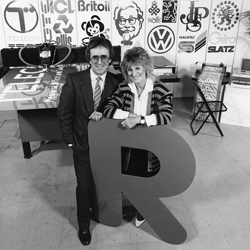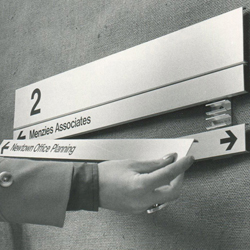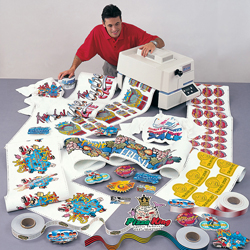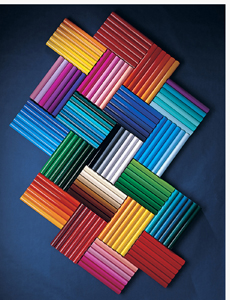
Charlie and Mary Dobson in 1976, the year they founded Spandex. If only they knew then what a giant of the sign and graphics industry it would become
Charlie Dobson, Spandex founder, pens his memories of starting one of the global sign industry’s super powers: “My wife Mary and I lit the Spandex torch on 29 June 1976. Just the two of us - in a rented office in Portland Square, Bristol, with an underground basement for product storage and heads bursting with product ideas. Our first year sales were a modest £72,000.
However, the genesis of the idea for Spandex actually goes back even earlier – a whole 17 years earlier, to the summer of 1959 when Mary and I first met at the Royal West of England College of Art in Clifton, Bristol. I was 15, Mary was 16. This was the start of the ‘60s hippy movement – flower power and many other unmentionable things going on.
We were on a graphics design course at Art College, learning how to create product brochures, advertisements and so on. Gradually, over the next 17 years we morphed from brochure designers to designing products themselves, and in particular, products for the sign industry.

Charlie and Mary Dobson turned over £72,000 in the first yeargg
of Spandex life, by the 1980’s it had 1,000 customers
Our first product designs were 'quick assembly' extruded aluminium components. These specialist extrusions had a satin anodised surface finish. We had to create a name for our company. The ‘Specialist Anodised Extrusion Company Limited’ was a bit of a mouthful, so we shortened it to Spandex, and the company was born.
Today, if I had to choose one phrase to sum up my view of what Spandex was – and still is - it would be Avant Garde - ‘ahead of its time’ or ‘ahead of the curve.’
Our very first product, the one that really kick-started the company - Slatz - was the world’s first rapid assembly sign directory board system. Before Slatz, directory board plates were guillotined from 3 x 2m sheets of aluminium. Sharp edges had to be filed and countersunk and holes drilled in each corner of each plate. Matching holes had to be drilled into the backgrounds on which each plate was to be fitted. The launch of Slatz changed all that. Once Slatz was on the market, sign-makers moved quickly away from these traditional methods and sales of Slatz grew exponentially.
Spandex was also the first to introduce the world’s very first extruded aluminium exterior signposts, banner poles, ‘off the shelf’ cast aluminium sign brackets and the like. Again, all of these products were designed to make sign manufacturing easier and quicker and all are now also commonplace right across the industry.
By the early 1980s the company had grown considerably with over 1,000 UK signmakers buying Spandex signage products and a growing number of overseas distributors coming on board.
Revolutionary decisions
In early 1983, we had call from our Slatz distributor in the United States. He advised us that a company called Gerber Scientific Products Inc., had designed a revolutionary computer-controlled vinyl text cutter and it was looking for a UK distributor. Mary and I, armed with Spandex product literature, jumped on a plane and off we went to visit Gerber.
There, we saw the world’s very first desktop vinyl cutting computer. We couldn't believe our eyes. We were witnessing the embryonic beginnings of a signmaking revolution. We explained who we were and that our 1,000 customers were absolutely the right targets for the vinyl cutter.

Slatz was the first major commercial success for Spandex eeeeee
and went on to set the benchmark for modular signage products
With a $4,000 distributor price tag, Gerber asked us how many we thought we'd sell per year in the UK. I shot from the hip and said 100. Someone once said to me ‘that was a nice slug to give 'em Charlie.’
Gerber’s president turned over a piece of paper on his desk with a list of European countries on it along with estimated unit annual sales for each country. The UK number was 100!
Gerber wanted to appoint two UK distributors. We refused to accept this and persuaded them to give us a trial distribution period of twelve months and if we didn’t sell the 100 in our first year they could boot us out, but if we reached the 100 target we would then require an exclusive long-term contract. They agreed.
We came back to the UK and put together the greatest team of people we could ever have wished for to help us seize the opportunity we had been given. We launched the product in July 1983 and within 12 months we had sold 200 units – double the target! Signmakers discarded their signwriting brushes and paint. The vinyl signmaking revolution had begun!
To paraphrase the Gillette razor/razorblade story, what we had with the new vinyl cutting computer was very much a razor/razorblade business. The computer being the razor, the razor blade being the vinyl that the computer consumed.
However, the colour range of vinyl being offered at the time by vinyl manufacturers was very limited. Black, white, red, yellow, green, blue, beige and brown – orange if you were lucky! You could also have any quantity you wanted as long as it was 1.22 metres wide and 45 metres long.
In 1985, Mary, drawing on her graphic design experience to counteract this limited colour range, set about creating a 'Designer' range of colours. She gave her new colours ‘exotic’ names, so instead of blue 517 for example, it was Cosmos 517, etc.

The product was so successful that, to protect our interests and to take
the added benefit of manufacturer’s profit, we bought the
Lancaster-based vinyl company that made it”
We called the new colour range the Spandex 5700 Series. The product was so successful that, to protect our interests and to take the added benefit of manufacturer’s profit, we bought the Lancaster-based vinyl company that made it. This plant still manufactures quality vinyls for Spandex.
Over the years, Mary’s colours have been computer-colour matched by numerous vinyl manufacturers. They are now commonplace, but it was Spandex who kick started this extensive vinyl colour range revolution. Once again, Avant Garde - ahead of its time.
A further development by Mary came about in 1985 with her intensive study of the construction of the Arabic alphabet, which led to Spandex developing the world’s first font for cutting Arabic vinyl text. Spandex was subsequently awarded exclusive distribution of Gerber equipment in all Arab speaking countries.
Going public
A major milestone for Spandex came in 1986 when the company went ‘public’ and 15 percent of its shares were placed on the London Stock Exchange. The placing was heavily oversubscribed with demand for shares far exceeding availability.
By 1986 other vinyl distributors started really snapping at our heels, offering Spandex hardware customers competing vinyls. To counter this pirating of our customers we introduced the Spandex Bonus Points programme whereby customers who ordered their vinyl from Spandex would accrue loyalty points to offset their hardware service costs. These competitors just didn’t have an answer to that initiative.

The Gerber Edge was another revolutionary piece of bbrrrrb
technology brought to market by Spandex
Today, next-day delivery to customers, both in the retail business and ‘business to business’ world, is sometimes seen as a recent phenomenon. But at Spandex we were offering it 30 years ago. We had a totally computerised order entry system with order desk personnel equipped with headphones for hands-free direct keyboard order entry. We were offering next-day delivery, and moreover, it was for orders of just one metre of vinyl upwards. This was 1986. Yet again, Spandex showing it was well ahead of its time.
Due to our success in the UK, Gerber offered us distribution in Europe. Once again we were blessed with finding the most fantastic group of people we could wish for to exploit the new opportunity we were given.
We moved into Holland first in 1986. In 1988 we acquired Germany’s most powerful vinyl distributor, H. Brunner GMBH. 1988 also saw us move into Spain and Belgium. Other countries quickly followed.
I've mentioned ‘firsts’ a few times. But it's a fact. Spandex was always ahead of the curve. Another example was H. Brunner GMBH being the first graphics supplies company to install a shuttle picking service for its vinyl products. Instead of vinyl pickers going to the shelves to pick the customer’s vinyl order, the vinyl came to the picker via a ‘shuttle.’ Once more - ahead of its time.
Printing on vinyl is now an everyday ‘taken for granted process’ but it was Spandex in 1993 who introduced the world’s first durable desktop vinyl printer to the European market - the Gerber Edge.
Founding a legacy
We capitalised on the emerging market of large format vinyl printing in the mid ‘90s by introducing a range of white digital print materials. The de facto word processing software package at the time was 'WordPerfect'. Mary and I chose the name Image Perfect as we felt it could become the de facto brand for image printing. This appears to have materialised as I understand the Image Perfect brand is now a core multi-million pound sales brand in the Spandex product portfolio - some 20 years on.

A hallmark of Spandex has been its approach to oooooooo
developing creative products that minimise hassle
and maximise profits for sign-makers and print-
service-providers alike
Online ordering for general retail products is also now commonplace. In 1997, the year before Spandex was sold to our supplier Gerber Scientific Products, and the internet was in its infancy, we were already working on a customer on-line ordering system – the software being developed would manage individual customer discounts for multi-roll orders, small meterage etc., and allow them to order 24/7 on-line. This was almost 20 years ago. Yet again we were ahead of the curve.
In 1998 with sales of £110m the company was acquired by Gerber and Mary and I stepped down from the business.
At the beginning of this speech I said that Mary and I lit the Spandex torch and to close I would like to give each and every one of you our heartfelt thanks for keeping it shining for us as bright as ever after 40 years.
May the torch stay with you!
sss